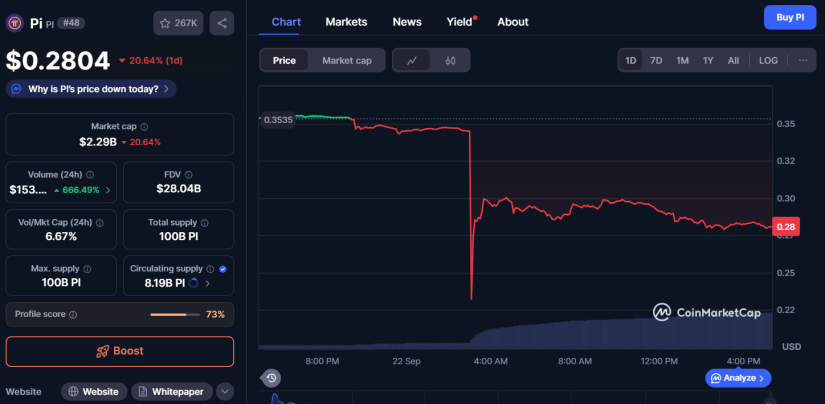TL;DR
Pi is experiencing a day of strong volatility as it implements a key verification update aimed at easing token migration to the mainnet.
PI’s current price is $0.2804, following a 20.6% decline in the past 24 hours. The drop partly reflects growing exchange balances, which reached a record 446 million tokens in custody, nearly half held on Gate.io. Additionally, more than 137 million tokens are scheduled to unlock next month, with 13.1 million set for October 1. That supply pressure coincides with a relative strength index near 29, indicating oversold conditions and a technical chance of a rebound.

Pi’s core team launched the Fast-Track KYC automated verification process to accelerate validation for eligible users and allow pre-mined coins to migrate to the mainnet without intermediaries. The previous requirement of 30 mining sessions was removed. Pioneers will receive notifications in the wallet to begin verification. Some residents will be able to use Banxa and complete the process in minutes, although that route requires purchasing a starter amount of tokens. Others can choose a fully on-chain verification without relying on third parties.
Fast-Track KYC aims to cut waiting times and free up human resources while maintaining identity acceptance standards. Automation should enable faster wallet activation and speed up testing of pre-mainnet applications. The team has linked this upgrade to preparation for a 100-dApp bundle ready for evaluation on the mainnet environment.

The market demands real liquidity and listings on reference platforms. Token migration to mainnet can increase immediate supply if not matched by greater demand or liquidity arrangements with exchanges. Therefore, although Fast-Track KYC reduces operational friction, it does not automatically neutralize selling pressure from unlocks and transfers to exchanges.
Community reaction has been mixed: some users view the drop as a buying opportunity; others call for clearer migration timetables and listing plans. Pi’s ability to stabilize its price will depend on turning the verification improvement into concrete outcomes: sustained listings, scheduled liquidity, and use cases that support demand. Meanwhile, the project must balance deployment speed with measures that contain selling pressure
Also read: Coinbase Introduces Hybrid Futures for Tech Stocks and Crypto ETFs